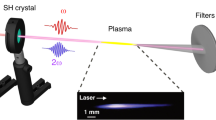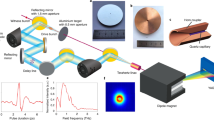Abstract
Terahertz (THz) radiation, which lies in the far-infrared region, is at the interface of electronics and photonics. Narrow-band THz radiation can be produced by free-electron lasers1 and fast diodes2,3. Broadband THz radiation can be produced by thermal sources and, more recently, by table-top laser-driven sources4,5,6 and by short electron bunches in accelerators7, but so far only with low power. Here we report calculations and measurements that confirm the production of high-power broadband THz radiation from subpicosecond electron bunches in an accelerator. The average power is nearly 20 watts, several orders of magnitude higher than any existing source, which could enable various new applications. In particular, many materials have distinct absorptive and dispersive properties in this spectral range, so that THz imaging could reveal interesting features. For example, it would be possible to image the distribution of specific proteins or water in tissue, or buried metal layers in semiconductors8,9; the present source would allow full-field, real-time capture of such images. High peak and average power THz sources are also critical in driving new nonlinear phenomena and for pump–probe studies of dynamical properties of materials10,11.
This is a preview of subscription content, access via your institution
Access options
Subscribe to this journal
Receive 51 print issues and online access
$199.00 per year
only $3.90 per issue
Buy this article
- Purchase on Springer Link
- Instant access to full article PDF
Prices may be subject to local taxes which are calculated during checkout




Similar content being viewed by others
References
Ramian, G. The new UCSB free-electron lasers. Nucl. Instrum. Methods Phys. Res. A 318, 225–229 (1992)
Porterfield, D. W., Crowe, T. W., Bradley, R. F. & Erickson, N. R. A high-power, fixed-tuned, millimeter-wave balanced frequency doubler. IEEE Trans. Microwave Theory Techn. MTT-47, 419–425 (1999)
Siegel, P. H. Terahertz technology. IEEE Trans. Microwave Theory Techn. MTT-50, 910–928 (2002)
Auston, D. H., Cheung, K. P., Valdmanis, J. A. & Kleinman, D. A. Cherenkov radiation from femtosecond optical pulses in electrooptic media. Phys. Rev. Lett. 53, 1555–1558 (1984)
Bonvalet, A., Joffre, M., Martin, J. L. & Migus, A. Generation of ultrabroadband femtosecond pulses in the mid-infrared by optical rectification of 15 fs light pulses at 100 MHz repetition rate. Appl. Phys. Lett. 67, 2907–2909 (1995)
You, D., Jones, R. R., Bucksbaum, P. H. & Dykaar, D. R. Generation of high-power sub-single-cycle 500-fs electromagnetic pulses. Opt. Lett. 18, 290–292 (1993)
Nakazato, T. et al. Observation of coherent synchrotron radiation. Phys. Rev. Lett. 63, 1245–1248 (1989)
Chen, Q. & Zhang, X.-C. Ultrafast Laser Technology and Applications (eds Fermann, M. E., Galvanauskas, A. & Sucha, G.) 521–572 (Marcel Dekker, New York, 2001)
Zhang, X.-C. in Compound Optoelectronic Materials and Devices 69–80 (1995)
Cole, B. E., Williams, J. B. & King, B. T. Coherent manipulation of semiconductor quantum bits with terahertz radiation. Nature 410, 60–63 (2001)
Huber, R. et al. How many-particle interactions develop after ultrafast excitation of an electron–hole plasma. Nature 414, 286–289 (2001)
Winnerl, S. et al. Frequency doubling and tripling of terahertz radiation in a GaAs/AlAs superlattice due to frequency modulation of Bloch oscillations. Appl. Phys. Lett. 77, 1259–1261 (2000)
Neil, G. R. et al. Sustained kilowatt lasing in a free-electron laser with same cell energy recovery. Phys. Rev. Lett. 84, 662–665 (2000)
Nodvick, S. & Saxon, D. S. Suppression of coherent radiation by electrons in a synchrotron. Phys. Rev. 96, 180–184 (1954)
Hirschmugl, C. J., Sagurton, M. & Williams, G. P. Multiparticle coherence calculations for synchrotron radiation emission. Phys. Rev. A 44, 1316–1320 (1991)
Happek, U., Blum, E. B. & Sievers, A. J. Observation of coherent transition radiation. Phys. Rev. Lett. 67, 2962–2965 (1991)
Wang, D. X., Krafft, G. A. & Sinclair, C. K. Measurement of femtosecond electron bunches using a rf zero-phasing method. Phys. Rev. E 57, 2283–2286 (1998)
Lihn, H.-C., Kung, P., Settakorn, C. & Wiedemann, H. Observation of stimulated transition radiation. Phys. Rev. Lett. 76, 4163–4166 (1996)
Doria, A., Bartolini, R., Feinstein, J., Gallerano, G. P. & Pantell, R. H. Coherent emission and gain from a bunched electron beam. IEEE J. Quant. Electron. QE-29, 1428–1436 (1993)
Jaroszynsky, D. A., Bakker, R. J., van der Geer, C. A. J., Oepts, D. & van Amersfoort, P. W. Coherent start-up of an infrared free electron laser. Phys. Rev. Lett. 71, 3798–3801 (1993)
Berryman, K. W., Crosson, E. R., Ricci, K. N. & Smith, T. I. Coherent spontaneous radiation from highly bunched electron beams. Nucl. Instrum. Methods Phys. Res. A 375, 526–529 (1996)
Tamada, H., Tsutsui, H., Shimoda, K. & Mima, K. Features of the compact photon storage ring. Nucl. Instrum. Methods A 331, 566–571 (1993)
Andersson, A., Johnson, M. S. & Nelander, B. Coherent synchrotron radiation in the far infrared from a 1-mm electron bunch. Opt. Eng. 39, 3099–3105 (2000)
Arp, U. et al. Spontaneous coherent microwave emission and the sawtooth instability in a compact storage ring. Phys. Rev. Spec. Topics Accelerat. Beams 4, 54401 (2001)
Carr, G. L. et al. Observation of coherent synchrotron radiation from the NSLS VUV ring. Nucl. Instrum. Methods A 463, 387–392 (2001)
Giovenale, E. et al. Longitudinal phase-space manipulation: a device to enhance the coherent emission from an RF modulated electron beam. Nucl. Instrum. Methods 437, 128–133 (1999)
Yu, L. H., Johnson, E., Li, D. & Umstadter, D. Femtosecond free-electron laser by chirped pulse amplification. Phys. Rev. E 49, 4480–4486 (1994)
Jackson, J. D. Classical Electrodynamics (Wiley, New York, 1975)
Hulbert, S. L. & Williams, G. P. Handbook of Optics: Classical, Vision, and X-Ray Optics Vol. III, Synchrotron Radiation Sources, 2nd edn (eds Bass, M., Enoch, J. M., Van Stryland, E. W. & Wolfe, W. L.) 32.1–32.20 (McGraw-Hill, New York, 2001)
Moeller, K. D. et al. . Appl. Opt. 30, 4297–4301 (1991)
Acknowledgements
We thank our colleagues for their help and support, which were essential for these experiments. This work was supported primarily by the US Department of Energy. The Jefferson Laboratory FEL is supported by the Office of Naval Research, the Air Force Research Laboratory, the Commonwealth of Virginia and the Laser Processing Consortium.
Author information
Authors and Affiliations
Corresponding author
Ethics declarations
Competing interests
The authors declare that they have no competing financial interests.
Rights and permissions
About this article
Cite this article
Carr, G., Martin, M., McKinney, W. et al. High-power terahertz radiation from relativistic electrons. Nature 420, 153–156 (2002). https://doi.org/10.1038/nature01175
Received:
Accepted:
Issue Date:
DOI: https://doi.org/10.1038/nature01175
This article is cited by
-
Terahertz Radiation Generation by Hermite-cosh Gaussian and Hollow Gaussian Laser Beams in Magnetized Inhomogeneous Plasmas
Brazilian Journal of Physics (2023)
-
Recent advances in terahertz imaging: 1999 to 2021
Applied Physics B (2022)
-
Experimental demonstration of the mechanism of steady-state microbunching
Nature (2021)
-
THz guided-mode resonance notch filter with variable filtering strength
Scientific Reports (2021)
-
Observation of terahertz coherent edge radiation amplified by infrared free-electron laser oscillations
Scientific Reports (2021)
Comments
By submitting a comment you agree to abide by our Terms and Community Guidelines. If you find something abusive or that does not comply with our terms or guidelines please flag it as inappropriate.



